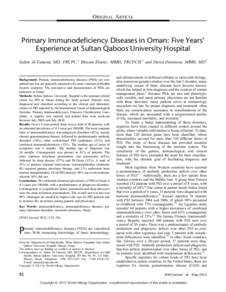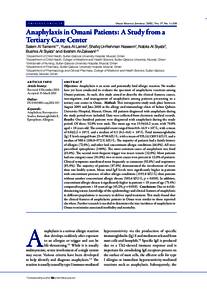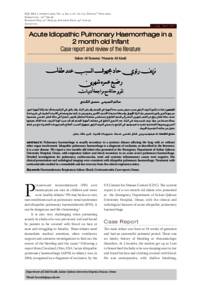Document
Primary immunodeficiency diseases in Oman : five years' experience at Sultan Qaboos University Hospital.
Identifier
DOI: 10.1097/WOX.0b013e318258830f
Contributors
El-Nour, Ibtisam., Author
Dennison, David., Author
Publisher
BioMed Central Ltd.
Gregorian
2012-05
Language
English
English abstract
Primary immunodeficiency diseases (PIDs) are considered rare but are generally assumed to be more common in Middle Eastern countries. The prevalence and characteristics of PIDs are unknown in Oman. Methods: Sultan Qaboos University Hospital is the national referral center for PID in Oman during the study period. Patients were diagnosed and classified according to the clinical and laboratory criteria of PID reported by the International Union of Immunological Societies Primary Immunodeficiency Diseases Classification Committee. A registry was created, and patient data were analyzed between July 2005 and July 2010. Results: Over a 5-year period, there were a total of 90 patients, with an estimated prevalence of 4.5 cases per 100,000. The most common form of immunodeficiency was phagocyte disorders (42%), mainly chronic granulomatous disease, followed by predominantly antibody disorders (18%), other well-defined PID syndromes (13%), and combined immunodeficiencies (12%). The median age of onset of symptoms was 9 months. The median age of diagnosis was 24 months. Consanguinity was present in 81% of patients. The most common infectious presentation was pneumonia (42%), followed by deep abscess (27%) and BCGosis (12%). A total of 25% of patients required intravenous immunoglobulins treatment, 4% required gamma interferon therapy, and 11% underwent bone marrow transplantation. Of all PID patients, 90% survived treatment, whereas 10% did not. Conclusions: The estimated minimum prevalence of PID in Oman is 4.5 cases per 100,000, with a predominance of phagocyte disorders. Consanguinity is a significant factor; pneumonia and deep abscesses were the main infectious presentations. The overall survival rate was 90%. Strategies are needed to improve the care for PID patients and to increase the awareness among parents and physicians.
Member of
ISSN
1939-4551
Resource URL
Category
Journal articles



